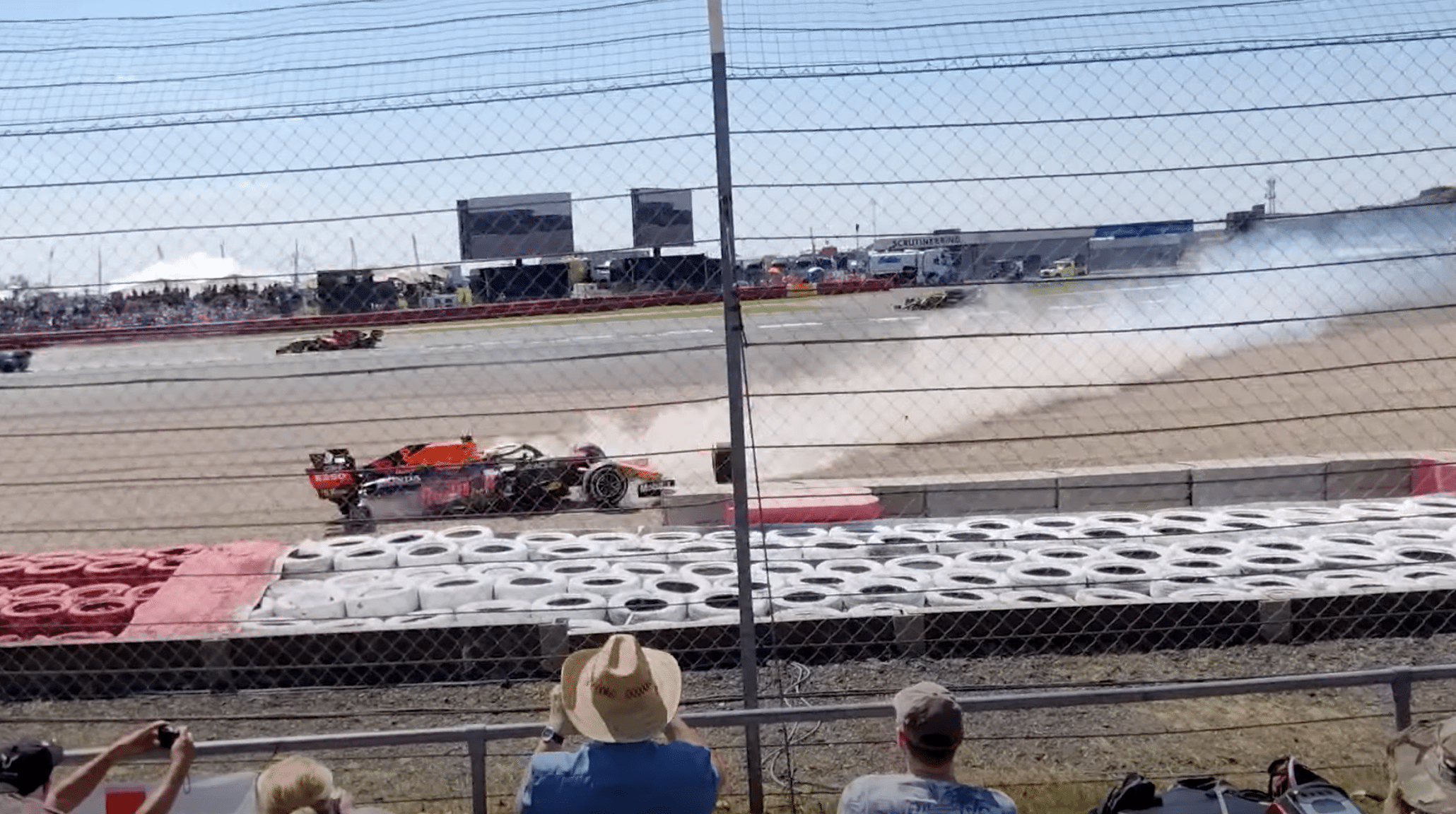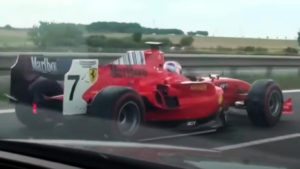Speed doesn’t kill you. On May 26, 1969, the Apollo 10 command module clocked an almost unfathomable 39,938 km/h (that’s 11 kilometres per second) during its return to Earth from a round-trip of the Moon. To date, it’s the fastest humans have ever travelled.
A little closer to home, Andy Green broke the sound barrier when he achieved the outright land speed record of 1,228 km/h at the controls of a jet-powered car in 1997.
Both of these achievements make the average top speed of a current-generation Formula 1 car – approximately 330 km/h – look like a snail’s pace. Yet still, despite being blindingly fast, it won’t kill you.
Hitting a wall is what kills you. Deceleration. Stop dead in your tracks from any of these speeds, and you’ll be just that: dead.
Formula 1’s g-forces are immense, there’s no doubt about that, but it’s inertia that’s the true killer. And while acceleration and deceleration might seem like basic high-school science, the physics behind gravitational force (known as g-force) in the world of Formula 1 is a threat worth unpacking to truly appreciate the likes of Red Bull’s Max Verstappen walking away from his colossal crash at the British Grand Prix back in 2021.
On the opening lap at Silverstone, Verstappen was defending his pole position from Mercedes’ Lewis Hamilton as they went wheel-to-wheel into one of the fastest corners on the circuit, Copse. After hammering down the straight at speeds in excess of 300 km/h, the world champion’s front-left wing caught the Dutchman’s rear tyre as they made the turn, careering the latter into the barriers for an impact that Red Bull’s data analysts clocked at 51g.
But what does 51g really mean? How does it stack up on a scale of neck-snapping impacts and g-forces commonly experienced in Formula 1?
The constant g-force that mere mortals experience while going about their daily business is 1g. This is the amount of force that Earth’s gravitational field exerts on the body at sea level. Any time that an object (or person) changes its velocity faster than gravity can change it, the forces will be greater than one g. Astronauts in space experience zero-g, because up there, beyond the pull of Earth’s gravity, that force doesn’t exist. Simple enough.
Gravitational forces can be pushed onto the body both vertically and horizontally, as well as forward and backward. The pick of the bunch is horizontal g-force – also known as lateral g – as the body gets squished under its own weight perpendicular to the spine. What you definitely want to avoid is vertical g-force (the likes of which fighter pilots experience), which compresses the spine from the top down and rushes blood towards and away from the brain. No blood in the brain means no lights are on when you need them most, leading to unconsciousness and, at the controls of a warplane, either life or death.
In a normal F1 race, drivers experience up to 4 or 5 lateral g routinely under braking and cornering, or anywhere the car speeds up or slows down between zero and 330+ km/h. And they’ll do so in only a couple of seconds. But what happens when this deceleration rate is pushed exponentially right up to catastrophic – i.e. when coming to a screeching halt into a concrete wall?
Incredibly, the human body can tolerate localised g-forces in the hundreds for a split second. Even a solid right hook to the chin may register a 100g locally without imposing any lasting damage. A sneeze results in about 2g of acceleration. A 2019 study by the American Academy of Neurology concluded that the average g-force experienced in a rugby tackle was 21g.
Hurtle towards a barrier in an F1 car, with the entire body exposed to this same share of force, however, and you’ve got a recipe for disaster.
Factors that influence the effects of deceleration are the initial rate of speed, the distance covered – and time consumed – in deceleration, the direction of forces, as well as the area of distribution.
RELATED: A Man’s Fighting Ability Is Written On His Face (According To Science)

Ready for a quick physics lesson? Stay with us.
If you were to throw an apple out of a window, the effects of Earth’s gravity would have it falling at a rate of 9.81 m/s2. That means after one second it’ll fall at an average speed of 9.81 m/s. After two seconds, it’ll be falling at 19.62 m/s, and so on, until it hits terminal velocity.
When Verstappen hit the wall at Turn 9, his peak rate of deceleration was reportedly 51 times greater than gravity in a lateral direction, which is a deceleration rate of 500.31 m/s.
Let’s say that Verstappen’s speed into the barrier was a modest 180 km/h (likely more, possibly less, although that information has yet to be confirmed). That’s equivalent to a speed of 50 m/s.
Taking a line from your high-school physics textbook (and from Top Gear’s analysis of when Carlos Sainz crashed at Sochi back in 2015), we can use the equation v = u + at to work out how long it took the tyre barrier to stop him, as well as how many times his normal bodyweight crushed him into the wall.
If v (final velocity) is zero, and u (initial velocity) is 180 km/h (or 50 m/s), then the total time taken would be 50 m/s divided by his deceleration rate of 500.31 m/s. So by our calculations, Verstappen experienced this outrageous g-force in a hyper-compressed time period of just 0.099 seconds.
Therefore Verstappen’s official weight at 1g (72 kg) – for just a tenth of a second – was multiplied into an astounding 3.6 tonnes of mass crushing him into the barrier at 51g.
Think that’s outrageous? In 2007 at the Canadian Grand Prix, Robert Kubica’s spectacular high-speed accident destroyed his Sauber after it collected the wall at 75g. Miraculously, he walked away with hardly a scratch.
Way back in 1977, F1 driver David Purley survived an estimated 179.8g when he decelerated from 173 km/h to zero over a distance of just 66 cm. His throttle was reportedly stuck open, and unable to recover control of the car, he hit a wall head-on. To this day, it’s one of the highest g-forces someone has ever survived.
If we’re really talking about the highest, though, so far, the undefeated champion of deceleration survivors has to be Kenny Bräck – a Swedish racer who collected the fence at the Texas Motor Speedway in 2003 at an outrageous 214g. Understandably, such a force is so incredible that you’re excused if you find it difficult to believe.
So there you have it.
Now, after all of that, aren’t you curious as to what exactly happens to an F1 driver’s body under such force?
One of Mercedes’ team officials once told The Sunday Morning Herald after the 2019 Australian Grand Prix that at the end of the straight, the g-forces were, “… pulling the tears out of [Lewis Hamilton’s] tear ducts, and he could see them splashing on to his visor under braking.”
Now all you have to do is imagine what happens to the brain inside your skull when you go from hero to zero at 300 km/h. Thankfully, Formula 1 is safer than ever before. Just ask Romain Grosjean.
Now, check out fellow Dutchman and global DJ/producer, Martin Garrix, actually flying an F-16 fighter jet and experiencing vertical g-force at its most powerful.
















